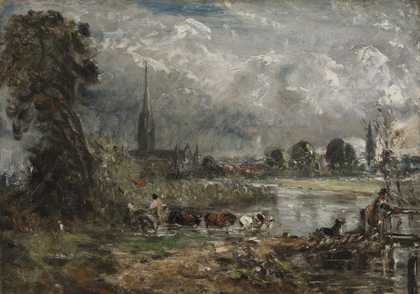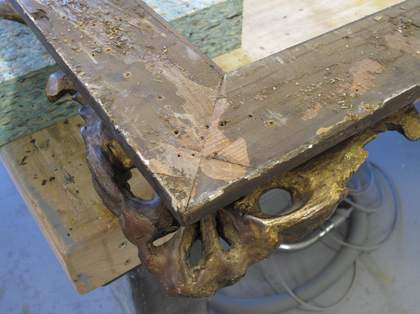
John Constable
Salisbury Cathedral from the Meadows (?1829)
Tate
I have often admired the paintings of John Constable (1776–1837) for their capacity to appear tough, veiny and raw. I am also struck by his use of corpuscular and clotted paint, creating surfaces that are mottled and distressed, and yet so airy.
Constable is one of the first painters, to my mind, to make gesture – scumbling, scraping, thinness, viscosity, impasto, the ‘stuff ’ of painting – read as part of the content of the work. In other words, the means of creating a picture is in perfect alignment with its ends.
In his work, the technique is not an effect tacked on afterwards, nor is it hackneyed formula giving the appearance of search. It is absolutely integral to the process of representation, and if something is to be sacrificed it is the illustrative and obvious.
In Sketch of Salisbury Cathedral from the Meadows c.1829, a studio sketch for the larger, better-known oil painting, the now ubiquitous pastoral of the English countryside is abstracted and subsumed in an operatic intensity of virtuosic paint handling. Very few artists achieve this sort of radical realism, which both embeds the experience of perception within the act of recording and allows the specificity and unique character of the place to radiate through. Scab-like sienna encrustations float alongside flickers of Van Dyke brown; acrid cadmium-green swamps emerge and yellow-ochre leaves jut from burnt umber branches: this is a painter’s world and the sheer immediacy is breathtaking.
The dark tree on the left side of the painting reaches Willem de Kooning levels of abstract gesture and is a prophetic declaration of the potential of painting, which – aside from a few notable exceptions – would take more than a century to materialise.
As much as I revel in Constable’s mastery of touch, I am equally impressed by his ability to describe and affirm the everyday world around him. Humble, plodding animals and a farmer engaged in some mundane activity become the scene of ominous wonder, a stark contrast to dumbed- down depictions of most rural landscapes. It brings to mind some lines from Gerard Manley Hopkins’s 1877 poem ‘God’s Grandeur’: ‘The world is charged with the grandeur of God. / It will flame out, like shining from shook foil; / It gathers to a greatness, like the ooze of oil / Crushed.’ What words could better describe this painting?
This is exactly my point: that in the materials lies this metaphorical referent to the world outside. It is like bringing the world in: paint is pigment (earth) and oil the muck on the boots of the farmer and the cow’s dung. Constable’s genius is the extreme polarity, yet perfect balance, he achieves between the prosaic subject matter, the charged drama of nature and the raw immediacy of oil paint.
John Constable’s Sketch of Salisbury Cathedral from the Meadows was bequeathed by Henry Vaughan in 1900. Along with 60 other works from the Tate Collection, it is included in the exhibition Constable: A History of His Affections in England, Mitsubishi Ichigokan Museum, Tokyo, until 30 May. The exhibition is organised with the Asahi Shimbun in collaboration with Tate.
Sky Glabush is an artist who lives and works in London, Ontario.

